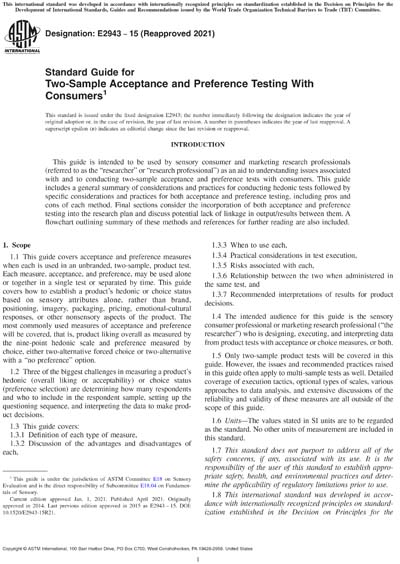Most recent
ASTM E2943-15(2021)
Standard Guide for Two-Sample Acceptance and Preference Testing With Consumers
1.1 This guide covers acceptance and preference measures when each is used in an unbranded, two-sample, product test. Each measure, acceptance, and preference, may be used alone or together in a single test or separated by time. This guide covers how to establish a productâ's hedonic or choice status based on sensory attributes alone, rather than brand, positioning, imagery, packaging, pricing, emotional-cultural responses, or other nonsensory aspects of the product. The most commonly used measures of acceptance and preference will be covered, that is, product liking overall as measured by the nine-point hedonic scale and preference measured by choice, either two-alternative forced choice or two-alternative with a “no preference†option.
1.2 Three of the biggest challenges in measuring a productâ's hedonic (overall liking or acceptability) or choice status (preference selection) are determining how many respondents and who to include in the respondent sample, setting up the questioning sequence, and interpreting the data to make product decisions.
1.3 This guide covers:
1.3.1 Definition of each type of measure,
1.3.2 Discussion of the advantages and disadvantages of each,
1.3.3 When to use each,
1.3.4 Practical considerations in test execution,
1.3.5 Risks associated with each,
1.3.6 Relationship between the two when administered in the same test, and
1.3.7 Recommended interpretations of results for product decisions.
1.4 The intended audience for this guide is the sensory consumer professional or marketing research professional (“the researcherâ€) who is designing, executing, and interpreting data from product tests with acceptance or choice measures, or both.
1.5 Only two-sample product tests will be covered in this guide. However, the issues and recommended practices raised in this guide often apply to multi-sample tests as well. Detailed coverage of execution tactics, optional types of scales, various approaches to data analysis, and extensive discussions of the reliability and validity of these measures are all outside of the scope of this guide.
1.6 Units—The values stated in SI units are to be regarded as the standard. No other units of measurement are included in this standard.
1.7 This standard does not purport to address all of the safety concerns, if any, associated with its use. It is the responsibility of the user of this standard to establish appropriate safety, health, and environmental practices and determine the applicability of regulatory limitations prior to use.
1.8 This international standard was developed in accordance with internationally recognized principles on standardization established in the Decision on Principles for the Development of International Standards, Guides and Recommendations issued by the World Trade Organization Technical Barriers to Trade (TBT) Committee.
Content Provider
ASTM International [astm]






